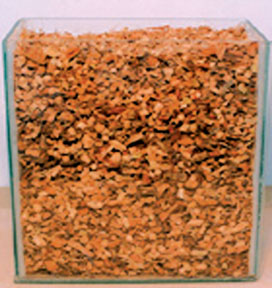Feasibility study on coco peat export
by Sapumali GALAGODA
The demand for coco peat in the Netherlands continues to increase by
20 percent on average year on year. Therefore, if the horticultural
industry is the identity of the Netherlands, coco peat is its breath of
life, states the Exporter Magazine.
Almost 100 percent of the horticultural materials planted in non-soil
media in the Netherlands, is cultivated on coco peat.
 |
|
Fibre mixed coco peat |
There are many reasons for using coco peat. It is a renewable
planting media as it is derived from coconut fibre. Coconut fibre is
abundantly available in tropical countries where coconut is commonly
cultivated. Coco peat can replace the original peat obtained by the
decomposition of plant material such as the genus sphagnum, is becoming
more difficult to obtain now.
Another important reason is that the use of coco peat provides many
benefits during the process of cultivation.
This planting medium could store water well so that it can extend the
duration between sprinkling. It could also at the same time reduce the
frequency of fertilizing because the solution of fertilizer could be
stored in this medium longer.
Due to its natural properties the water storage capacity of coco peat
will not be lost even when the growing medium becomes dry. As such when
watered the dry coco peat will be able to retain water again. Therefore,
it is different from common peat which cannot retain water again once it
gets dry. Coco peat is also more durable because it takes longer to
decompose compared to peat moss, for example.
The demand for coco peat is supplied by coco peat producers based in
the Netherlands. In the Netherlands every coco peat producing company
must obtain recognition from the Accreditation Institution which
controls the quality and effectiveness of the coco peat.
This recognition ensures that the quality of coco peat is accepted
all over the world. It is important because the coco peat market for
producers in the Netherlands is both in countries within Europe and
outside Europe.
Coco peat produced by a company owned by Bas Van Bauren (BVB) as well
as other companies is derived from coconut fibre (coco fibre) or
half-finished coco peat.
Coco fibre from all types of coconut could be processed into coco
peat. It is imported from coconut producers in tropical countries. Dry
coco fibre is shipped in bales, loaded in 40 foot containers. Each year
at least 1,500 containers of coconut fibre are imported by the
Netherlands from India, Sri Lanka, Vietnam, Ghana, Ivory coast,
Dominican Republic, Mexico and Brazil.
The import volume increases continuously from year to year. The
requirement for coco fibre to enter the Netherlands is very strict. It
must be free from weeds, pathogenic nematodes, stones and sand.
Basically it must be sterile.
In the country of origin, coconut fibre undergoes both mechanical and
chemical processes.
The fibre is cut into small pieces. Thereafter, the sodiumand
Potassium complex contents in the fibre are chemically changed into
Calcium and Magnesium.
Every year, representatives of coco peat producing companies inspect
coconut plantations in the coconut producing countries, and local
companies which process the coco fibre to be shipped to the Netherlands.
The treatment process prior to export must comply with procedure and
standards issued by the European certification body for the Agriculture
sector (ECAS). After arriving in the Netherlands the fibre is checked
again to ensure that it is free from contaminants.
Sri Lanka as one of the coconut producing countries has an
opportunity to export coconut fibre to the Netherlands.
However, the stringent requirements of the importing country and the
tough competition from other producers need to be considered. Therefore,
a study to determine the quality required by importers in the
Netherlands should be undertaken.
Prospective investors should also assess the costs of production and
transportation compared with that of producers in other coconut
producing countries.
One of the largest coco peat producers is a company owned by Bas Van
Bauren (BVB) in Massland, Rotterdam. BVB producers six major coco peat
media based compositions that are suitable for various crops. For
example, a growing medium consisting of 100 percent coco peat is used
for gerberas, roses, carnations and various vegetable crops.
For lilies a medium composed of 50 percent coco peat and 50 percent
soil is used. A composition of 50 percent coco peat and 50 percent peat
moss is used for Begonias. Dendrobiums need a medium which consists of a
mixture of 80 percent normal coco peat and 20 percent coarse and fibrous
coco peat. Growers could order any composition that is suitable for
their plants.
Various media compositions are developed to cater to the needs of
different types of plants and is also related to cost savings for the
growers.
A 100 percent coco peat medium is more expensive than that of a coco
peat mix.
Some 50 percent of the total production volume per year of BVB is for
exports to at least 50 countries within Europe and outside Europe.
In order to meet diverse consumer needs, BVB is fully equipped with a
modern laboratory.
Every coco peat shipment is checked for compliance with buyer needs.
Media composition errors could cause the failure of plant cultivations.
As such the computerised system used by BVB manage the hundreds of media
compositions that are suitable for the needs of various plants.
|

